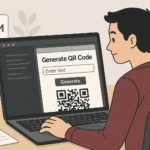AI and the Evolution of User Interface Design
The digital world has come a long way over the past few decades, but nothing has shaken things up quite like artificial intelligence (AI). Whether it’s Netflix suggesting your next binge-worthy show or Siri helping you find the nearest coffee shop, AI is quietly reshaping how we interact with technology and it’s changing the way we think about user interfaces (UI) in the process.
A Blast from the Past: Command Lines to Graphical Interfaces
You probably can’t remember a time when using a computer was as simple as typing all these difficult commands because, well, you’ve likely never done that. But, see, back in the day, unfamiliarity with command line interfaces (CLIs) served as an enormous barrier because things didn’t work unless you knew what you were doing. And then in the 1980s, everything swung around. Graphical user interfaces (GUIs) were born; icons, windows, and buttons were developed. So computers became friendly to almost anyone: not only those holding computer science degrees but instead just needing to learn to point and click.
AI Steps Into the Spotlight
Fast forward to today, and AI is the star of the show. It’s not just a buzzword; it fundamentally transforms the way we design and interact with interfaces. Here’s how: Personalization: AI knows you much better than you think. By analyzing your habits, it can craft tailored experiences just for you. Ever wondered why Spotify’s playlists feel as if they were made just for you? That’s AI at work. Voice Assistants: More like talking to appliances for the first time not in a sci-fi movie but in real life. Thanks to Alexa, Siri, and Google Assistant, voice interaction is the rule now that forces design beyond the screen to engaging in smooth, natural conversation. Predictive Design: Instead of just reacting, AI predicts. For instance, a smart calendar suggests the most convenient time for a meeting based on one’s schedule, thus saving time and inconvenience.

Interfaces That Adapt to You
One of the coolest things about AI is how it lets interfaces adapt in real-time. Imagine browsing an online store that rearranges itself to show you products you’re most likely to love. It’s not magic, it’s AI. This kind of responsiveness doesn’t just make the experience better; it keeps users engaged and coming back for more.
The Flip Side: Challenges of AI-Driven Design
Of course, it’s not all smooth sailing. Integrating AI into UI design comes with its fair share of challenges:
- Privacy Concerns: Personalization relies on data, and that can make users nervous. How much information are we giving up, and who’s using it?
- Complexity: Designing AI-driven interfaces isn’t easy. It requires a mix of skills, from understanding machine learning to mastering user experience (UX) principles.
- Ethical Issues: AI isn’t perfect. Biases in algorithms can lead to unfair or unintended outcomes, so designers have to tread carefully.
What’s Next? The Future of UI Design
So, where do we go from here? The future of UI design is all about creating experiences that feel seamless and intuitive, almost like second nature. AI-powered augmented reality (AR) and virtual reality (VR) are already pushing boundaries, offering immersive environments that adapt to your behavior.
And let’s not forget the little things, those subtle animations and responses that make digital interactions feel natural. As AI gets smarter, these micro-interactions will become even more refined, making interfaces feel less like machines and more like partners.
The Big Takeaway
AI isn’t just changing UI design, it’s revolutionizing it. For designers, this means embracing new tools and techniques to create interfaces that are more personalized, intuitive, and ethical. The journey is just beginning, and the possibilities are as exciting as they are endless. The future of UI design isn’t just about technology—it’s about creating experiences that feel human.


